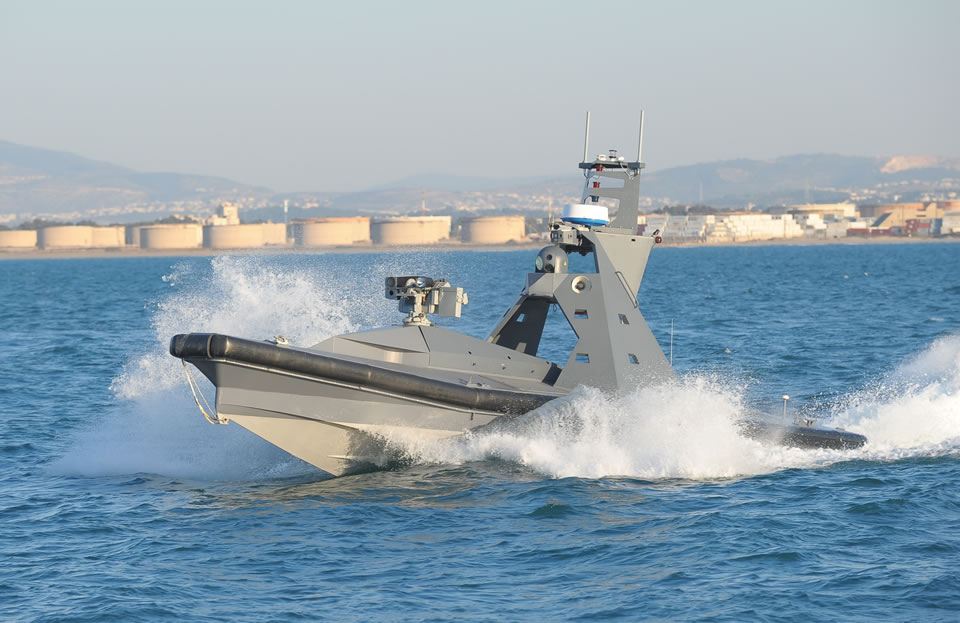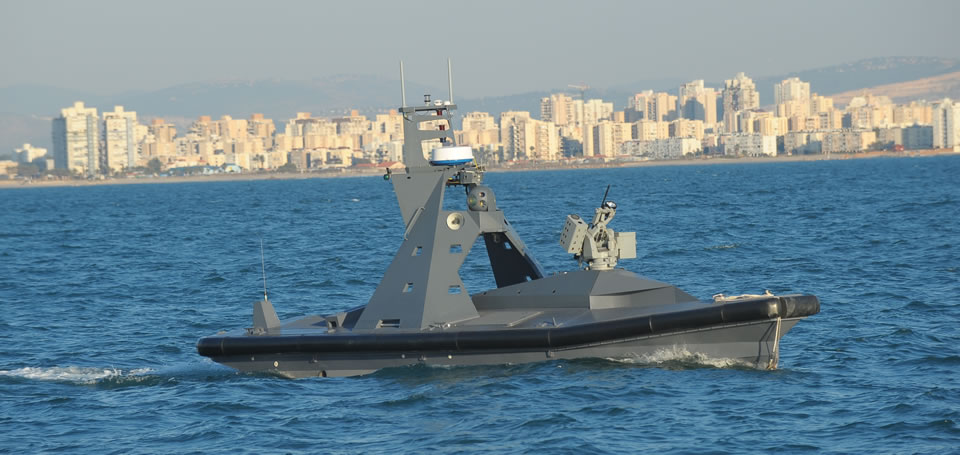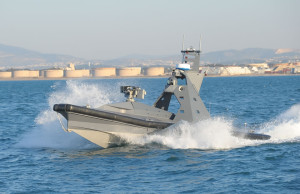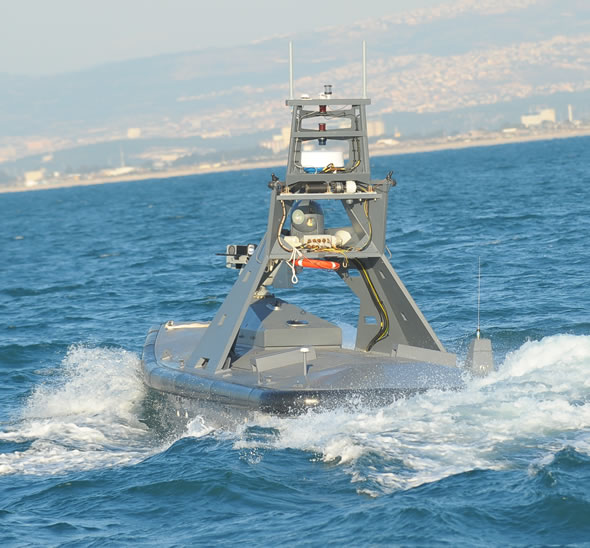

Developing Future Generations of Operators
In many historical cases, and specifically throughout the history of warfare, the introduction of new technologies changed not only the methods and tactics in which assets were being used, but also affected the profile of the soldiers and sailors operating them. Recently, a growing number of Unmanned Surface Vehicles (USVs) have been developed, and some are already deployed operationally by a number of navies. A lesson which can be learnt from the field of Unmanned Aerial Vehicles (UAVs), in which extensive operational experience has been gathered in the last two decades, is that operating a UAV is not as similar to flying a manned plane as was previously believed. In this article we wish to elaborate on the effects of technology on the operators of USVs.
One of the main differences between a UAV and a USV can be located in a basic difference between the concepts of operating airplanes and ships. This difference focuses on what is called “Situational Awareness”. Traditionally, airplanes are controlled by radar stations that provide the pilot with information about the surrounding area and the tactical picture. The air traffic controller oversees the mission using powerful aerial radar which enables him to understand the tactical picture better than the pilot, who is equipped with only a short range radar. The information from the air traffic controller is essential due to the fact that the pilot can only observe the tactical picture generated in short range (which is almost insignificant in relation to the speed at which the plane moves through the battlefield).
Ships however, have always been more independent. In the modern era ships are continuously working to formalize and decipher the tactical picture surrounding them on the surface of the sea, underneath it and in the air. In addition, maritime radars are inefficient over long ranges. Consequentially, with the shore line disappearing behind the horizon, sailors have to trust themselves and not relay on ground based radar stations.
Traditionally, navies are in charge of performing missions of military nature in the sea. This activity includes missions of Defensive nature such as safeguarding the state’s shores, enforcing law regulations at sea and securing sail routes. Missions of Offensive nature include attacking enemy vessels, imposing maritime blockade, projecting force in distant theaters, leading and assisting amphibious operations, intelligence gathering, assaulting shore based targets etc. A further classification of naval operation is Low Intensity and Traditional Warfare. Low intensity operation usually takes place close to the shore line using small maneuverable patrol boats or special forces and is aimed to cope with terror activities, infiltrators, illegal fishing, trafficking and smuggling. Traditional naval warfare takes place on the high seas, among large vessels such as frigates, destroyers, aircraft carriers and submarines. There are obviously many cases when large vessels are used as floating command centers in operations in which naval assets of all classes and sizes take part.
Remotely Controlling a Ship

A USV is a maritime platform (ship or submarine) which operates independently (autonomously) or controlled by a remote operator (i.e. an operator who is not stationed on the platform). Presently, operational USVs are controlled remotely from a control station located on shore or in the Combat Information Center (CIC) of a large command ship. USVs today are operated manually (i.e. being constantly observed by an operator) or in a semi-autonomous fashion (able to conduct simple tasks without the need for continuous supervision, as sailing in a predefined route and remaining in a certain location). The next generation of USVs is expected to have fully autonomous capabilities and will be capable of performing complex tasks independently.
Operating USVs is usually divided into two main functions – Boat and Payload. In principle, this division is similar to the divided responsibilities of a pilot and a weapons operator in fighter jets and attack helicopters. While Boat includes maneuvering and navigation as well as establishing the tactical picture around the USV, the payload function is responsible for operating the different devices mounted on the platform. These devices can include electronic warfare equipment, weapon systems, observation devices and intelligence gathering payloads.
The Boat console in the USV’s control station provides the operator with information necessary for controlling the platform. The Boat system is required to produce a situational awareness picture and provide the ability to remotely control the USV’s boat systems. The situational awareness system includes a display of the USV’s location and the arena (C²I), a video image of the surrounding area, a radar image, information from identification systems of various types (such as AIS) and other such abilities. The Boat system operator, the USV’s skipper in a sense, is responsible for the maneuvering of the USV and operating the USV’s Boat systems (such as the navigation equipment, flood pumps, fire extinguishing systems and the engines).
While the skipper performs the continuous operating of the USV, operating the payload is conducted from a separate console. Like the Boat console, the Payload console displays the status of the payload systems (direction of the weapon, video picture from a camera pod, sensor information etc.). The payload console provides remote control of these onboard systems. One of the differences between the two consoles is that the Boat console is usually generic to the type of the USV while the payload console and software can change according to the equipment installed on the platform and the nature of the mission: weapon payload for patrol, sonar for anti-submarine missions, cameras for intelligence gathering etc.
Can Any Naval Officer Command a USV?
In order to successfully operate maritime platforms, trained crews and their commanding officers are required to possess a range of technological capacities on top of their personal ones as fighters and sailors. A naval officer is required to introduce high personal abilities and technological together with profound understanding of the systems in his command. These skills are of utmost importance for two main reasons: firstly, navies assimilate advanced technologies in a fast pace due to the changing demands of the maritime battlefield. Secondly, as was previously discussed, a ship is an independent unit which does not have access to high level maintenance crews at sea. An officer has got to understand the technology at his disposal and to know how to fix and/or replace the systems he operates in case no help from external professional maintenance teams is available.

In modern vessels, a large portion of the naval officers’ activity is devoted to managing control rooms of various types. From theses control rooms the officers supervise the sailors who are responsible for different systems aboard the vessel. The officer is expected to understand the duties of the sailors under his command and to synchronize their work in order to operate the vessel. For example, the Tactical officer who is responsible for constructing the ship’s situational awareness, commands sailors who analyze and form the tactical situation picture which is presented to the ship’s captain. In order to provide the most accurate picture, the Tactical officer is required to coordinate the activity of sailors who operate radars, electronic detection systems, C²I computer operators, sonar etc. While forming the tactical picture, the officer is expected to understand the responsibilities of other officers onboard and the effect of his work on theirs. Following the previous example, after forming the tactical picture, the tactical officer is required to grasp the implications of the tactical situation on the ship regarding subjects such as maneuvering, weapons and countermeasures, all of which are under the responsibility of other officers (e.g. bridge officer, weapon’s officer and the EW officer).
Are the same professional skills relevant also for operation of USVs? Furthermore, should an officer operating a USV need to have the ability to function under fire? Does he need to set a personal example to the sailors under his command the way an officer on a manned platform is required to?
USVs will be integrated into existing naval array of missions and manpower. As was previously mentioned, changes in technology have always affected the characteristics of the men behind the machines. After analyzing the traditional missions of navies, the skills required from naval officers and the main functions of USVs, it is possible to start thinking about the dilemmas of operating USVs within the existing naval framework. It is worth asking what will be the characteristics of the new naval officer who will command such platforms, which changes will occur compared to the image of the traditional naval officer and what will be the meaning of command when the commander will no longer be present on board the platform.
Sensing the Virtual Deck
The operational envelope of a USV is different from that of an ordinary ship for a number of reasons. First reason is lack of information by comparison with manned platforms. Despite attempts by its developers, a USV operator does not receive all the data an ordinary skipper receives but only measurable information since only measurable data picked up by devices is sent through the air from the USV to the control station. A USV operator who is not alert enough can cause damage to the platform just because he is not exposed to the same acceleration forces that are imposed on the USV itself. Lacking this sensual information, the USV operator might decide to aim the USV sailing into high waves and increase speed, unaware of the physical implication of such a command. Giving a similar command, a manned platform’s officer will immediately realize (himself being rattled all over the command bridge) the necessity of changing course or reducing speed. In similar conditions, the USV operator will continue sitting comfortably in his chair. It is possible to circumnavigate this problem by automatic alarms and warnings, but too many of these can harm the mission and neutralize the advantages of the unmanned platform. Therefore, it is essential that USV operators will understand the sea conditions and their implications on the platform’s behavior.
Operating in harsh weather is only one example of many which illustrate the dilemmas connected to remotely controlling maritime platforms. The same argument is true of sailing at night, sailing according to radar picture alone (in case of fog or bad visibility) and sailing close to shore or other vessels etc. These dilemmas originate from the problematic distance between the operator and the platform, as is the case with USVs.
The USV operator is required to operate the platform using only sensor data, as a pilot flying “Instrument Flight” (flying an airplane without using visual information). The USV operator is observing a video image of the surrounding area but most of the maneuvering is conducted according to radar image and relative movement calculations (a process of extrapolating the direction and speed of a vessel in the real world from the radar image). These abilities are critical for operating and controlling a USV in an operational scenario.
Generally speaking, the USV operator is supposed to understand the tactical situation beyond the numerical data being displayed. He must be able to comprehend the implications of the maneuvers which he demands from the platform in the real situation at sea. The operator uses the information in the control station to imagine that he is onboard the USV, while understanding that this information is lacking. He therefore must fill in the gaps in the data by translating the numerical information to familiar physical sensations such as feeling the wind blowing on the face when the ship speeds up. After this translation the numerical data can be acted upon in order to control the USV. Experience can compensate for this lack of sensual data: an experienced operator can skip this stage of translating raw data into imagined physical sensations and use the numerical data as is. A USV operator’s training programs needs to address such issues through exercises and simulations.
Understanding the differences between manned platform and remotely controlled ones raises questions about the character of USVs operators. These questions are relevant to the training of operators as well as the basic personal characteristics required from the candidate. There is direct link between technological developments, the abilities required from the operator and the data that the system is required to provide in order to enable efficient control of the platform. As systems become more autonomous, human operators with different skills and different types of training will be required.
Maritime navigation is a prime example for the necessary changes in training. Today many hours are dedicated to teach naval officers how to navigate at sea by using many different methods. Are the same skills required from the USV operator? The new operational approach for USVs, which regards technology as the only means of navigation (and not the main one as in manned platforms), makes traditional training in this field unnecessary, or at least not essential.
Similarly, another question is of the necessity of command abilities from a USV operator. Naval manpower departments invest time and resources to locate candidates who have got command skills and train these candidates in order to further develop their basic abilities. Not being exposed to fire and managing only small crews, is the USV officer required to possess the same command abilities as a traditional naval officer? Is the leadership required from a USV’s operator similar to this of an officer in a ship’s combat information center? How does this new kind of command relate to the classical military command of an Infantry officer in the field?
Yet another dilemma rises when comparing to the world of maritime missile warfare: In the past, missile firing logic was based on human intervention, with the operator in charge the missile’s flight all the way to the target. Therefore, operators were required to have good eye-hand coordination and function well under pressure. Today, the automation of missiles requires precise pre-launch route planning but less intervention while the missile is in the air. It is reasonable to assume that a similar process will take place in the USV world in the future, i.e. operators will have to be skilled in strategic thinking and planning because most of their duty will be to plan an autonomous mission and not necessarily controlling the USV in real time.
It is well known that the sailors operating manned submarines can function well in closed and claustrophobia initiating environments. Do remotely controlled submarine operators need these same abilities? Is it wise to train them within the same organizations that train submariners? A thorough job requirement analyses may theoretically find similarities between remote submarine operation and seemingly unrelated fields. It is possible that departments within the navy other than submarine command, which specialize in training personnel for these similar duties (such as ground station radar operators school for example) are more suitable to train these “remote submariners”. Moreover, it is possible that the function most similar to that of a remote submariner will not be found even within the Navy. Research might imply that the skills required from remote submariner are similar to those required from air force flight simulation operators so that the knowledge of how to train them already exists. More investigation into this question is still needed.
Summary

The operational departments within the Navy are required to understand the implications of operational deployment of USVs and conduct the necessary changes in all aspects of command, control and mission performing. Similarly, manpower departments responsible for the recruiting and training of sailors and officers need information which will assist them to get ready for these changes.
Future sailors and naval officers will have to become accustomed to new technologies at a growing pace, and embrace new skills while they progress in their naval careers. Planning for many years in advance, manpower departments need established research data which will point out the directions of USV anticipated technological development. This will support preparing to future changes in manpower recruiting and training. In addition, such researches will provide insights into the skills required for operating future systems and encourage a much needed synergy between human-machine interface engineering and human skills development.
















